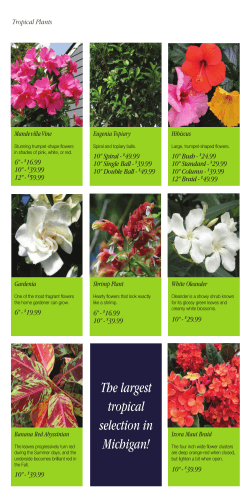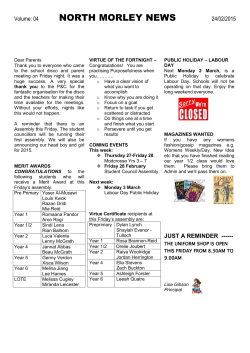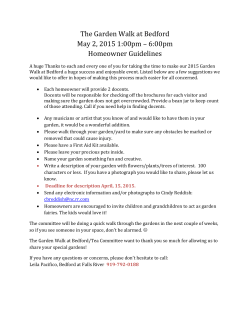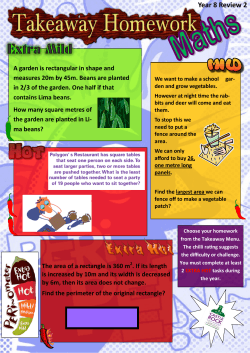
Scatter Info As We Bloom and Grow
Scatter Info As We Bloom and Grow Horticulture Edition, Gail Berthe, Editor Environmental Edition, Judy Keenan, Editor Landscape Design Edition, Jane Hersey, Editor Volume I, Number 19 Horticulture Edition April 2015 Two years ago GCG President, Suzanne Wheeler ask the three editors of Scatter Info As You Bloom and Grow to write quarterly ‘newsletters’ of general information pertaining to their specific topic: Horticulture, Landscape Design, and Environment. It was a privilege to work together to produce topics of specific interest to each of the three NGC schools to share statewide with GCG members. Now as this last issue of the 2013-2015 term of office ends we are happy to learn the publication will continue for Martha Price’s 2015-2017 term of office. The untimely passing of Suzanne on February 28, 2015 makes the continuation of this project she introduced all the more meaningful to us. Suzanne brought so many excellent ideas and concepts to our organization—we will continue to bring this newsletter to you. Please share your interests and comments with us to make this an even more effective publication. Thank you, Suzanne, for this opportunity to share information relating to favorite subjects. Observations from a Recent Trip to Arizona What does this have to do with Garden Club of Georgia?! We’ve been talking about sustainable gardening in past issues. Our recent dry summer seasons and environmental concerns about water conservation have made us cognizant of xeriscape landscapes featuring plants able to survive and be interesting with less water. Cactus/Succulents meet those needs and where are cactus/succulents more necessary than the very dry hot climate with soil that is totally unsuitable for much of the lush horticulture in other parts of the country. BUT, this is not to say some very amazing plants are growing in the incredible conditions of southern Arizona—Tucson/Phoenix area. Some of these same plants are hardy or marginally hardy in Georgia and can be very effective with proper planting considering drainage and winter temperature 1 Soil. Picture top right is bare soil with rocks that were exposed when the property was graded for the house construction. To the left is ‘how to dig a hole in Tucson! Our daughter in law is the ‘digger’ and a fabulous gardener. She is with the Denver Botanic Garden and has planned and executed the landscaping of their winter vacation house. Son supervised the building of the environmentally correct house (800 square feet and delightful) picture to the right is the Ocotillo (Fouquieria splendens) planted in the hold she dug. Ann also rescued the plant as a part of Plant Rescue Tucson—just like we do with Georgia native plants. Bottom left picture is a Buckthorn Cholla shrub which has been on the property for more than 50 years and is just bursting into lovely red blooms. Many more buds in this picture than full flowers, but needed the picture TODAY. You can tell I’m a bit proud of their accomplishment! Oh, it is so environmentally correct the house is built on the foot print of the previous home. Also they have installed a cistern for water collection and are using gray water where appropriate. This will be a winter get-away from Denver winter. Environmental Habitat Obviously these plants won’t grow year round outside in Georgia, —but there are many cactus/succulents that are hardy here IF drainage and winter hardiness are established. I’ve been using some for several years and enjoying them for their hardiness and beauty—I categorize them into three distinct groups: Those that stay outside all year long--planted in well-drained soil Container grown plants that are marginally hardy are wintered behind some big shrubs by the garage Some few (fewer every year!) are brought indoors to be enjoyed placed by sunny windows—where they are happy too. They require little special care—a bit of water once a month 2|Page Succulents make good container plants, including hanging containers They should be planted in lean, well-drained soil, porous enough that water runs nearly straight through. Many commercial ‘cactus soils’ contain organic material as opposed to mineral materials such as sharp sand and fine gravel. If the bag of ‘cactus soil’ is heavy it is suitable because it contains sharp sand/fine gravel. Light weight bag means it has too much organic material which holds water—not good for succulents. You can make your own container blend by mixing a good quality regular potting soil in a 50/50 mix of potting soil and sharp sand. Do not try to add ‘builders’ sand to your regular potting soil—remember that sand and clay is what is used to make bricks! Fertilizing should be done sparingly and with diluted fertilizer Don’t mix succulents with regular garden plants in a container Some succulents with which I’ve had good luck include Sedums—there are a wide variety from which to choose Echeveria—really interesting plants Gasteria—don’t look anything like their name! Graptopetalum—soft gray and a bit fuzzy Haworthia—dainty Start checking the internet and look at images of succulents—the big box stores all have small rooted cuttings available at a low price—try some and you may very well like them—and they are sustainable and xeriscape oriented. Propagation by Cuttings, Division, and Seed After swearing to never again try propagation by seed my late winter dreaming over the seed and plant catalogs has created the ‘urge to try again.’ Being a believer in waiting till the season settles down and is really past the ‘last frost date’ to plant anything tender, the stack of seeds is awaiting both indoor and outdoor planting. Selection includes those annuals and perennials which are not difficult to achieve success—we’ll see! Really must get some of them into ‘seed potting mix yet this week. It would be good to hear some of your experience with this skill. Years ago, GCG doyenne of horticulture, Jean Givens and I were talking, and she reported having planted some tree seeds! She said it was silly but future generations would enjoy them. She is such an inspiration. As you will recall Jean recently celebrated her 100th birthday! What do you think of my chances of getting some zinnias and marigolds to germinate!? The hard stuff plants have been 3|Page ordered from reliable nurseries! Fireworks gomphrena, and dragon wing begonia are on the top of my plants order! Division of perennials—this is generally not too difficult! Just best to do it at the right time of the year—basically late blooming plants (asters, chrysanthemums etc.) are divided in the spring and early bloomers (carpet phlox, ajuga) are divided in the fall. It is best to do any division when the soil is well hydrated and friable—not soggy. Carefully lift the mother plant from the ground—garden fork is good, and gently separate the roots of each individual plant, and replant in prepared soil as soon as possible. You will be accomplishing several worthy goals—gain more plants for your garden or to share, the mother plant will be rejuvenated to enjoy several more seasons of bloom, or a more favorable location may be gained. If you are dividing rhizomes (iris), bulbs (daffodils) wait till mid to late summer—carefully dig the rhizome/bulbs and replant following general instructions for the specific plant. There is an excellent web site, Dividing Perennials, from Clemson University. Cuttings—because we’ve already discussed this in a previous issue I just will share one example with you. When pruning the Knock Out roses and a few other ‘heritage’ roses this early spring I had some good cutting examples and being lazy just stuck them in a pile of really nice soil out in the woods and checked them the other day—many are rooting by signs of things—they are sprouting leaves! Of course these are very hardy plants and the soil was perfect. Will see in a few more weeks if there are indeed roots—don’t want to disturb them too soon. Now, good luck to you with this project to acquire more plants with little expense and a certain sense of accomplishment. What Is the Difference between Native Plant and a ‘Nativar’? The American Gardener for March/April 2015 posits the question about the difference between an unaltered native plant and what Alan Armitage calls a ‘nativar.’ Let’s establish some definitions first. A true ‘native plant’ is that plant which has not in any way been altered by human hand (which would make it a cultivar) and a ‘nativar’ which is a native plant that has been altered by human intervention to produce a specific plant which meets the special needs to make it more adaptable to the garden—hence the coining of the word ‘nativar’—a native plant changed to be more successful in the garden—size, resistance to disease, bloom size and configuration, color (think of all the many new colors, size, bloom available today in Echinacea.) Why isn’t this a good idea? This is simple to 4|Page answer—a native plant’s function is to benefit wild life—food, shelter. When a plant is hybridized it may no longer meet the needs of wildlife for various reasons such as the flower no longer produces pollen, or the pollen is no longer accessible because of multiple petals blocking access. Echinacea purpurea, Purple Coneflower Echinacea ‘Hot Papaya’ This is a good comparison of the pollen accessibility! But there are many factors to be considered in your decision of what to plant and grow. Thoughtful compromise is a possibility. Be aware not all goals can be achieved—ecologically and ascetically. (Photographs from Plant Delight Nursery—a very responsible plants nursery) What if the hybridization of a native plant which is susceptible to a specific insect or disease, and a hybridized ‘nativar’ is developed to solve this problem? Now the plant is available once more to be enjoyed by all. Dark-leaved ninebark [(Physocarpus opulifolius) which is only hardy to zone 7 in Georgia] is susceptible to native nine bark beetle but the newer cultivar ‘Diabolo’ is not bothered by the beetle BUT now the beetle is endangered! Life’s dilemmas! The answer lies in what are you trying to accomplish—maintain a ‘natural balance of nature’ or enjoy a specific landscape design!? The question then becomes “…among all the nativars available, what attributes should ecologically –minded gardeners be looking for?” Research has shown that some of the nativars most similar to their wild cousins are more likely to attract pollinators than an exotic nativar! Such a dilemma—“If your plants are not being eaten, they’re not supporting any insects. And without insects, the foundation of the food chain is compromised…the choice is the gardener’s decision. To ensure maximum wildlife value, it is recommended to use the true non-hybridized species. 5|Page What makes Cut Flowers Last Longer? Information is from fine Gardening, June 2015 As one who enjoys the garden to the fullest—especially the thrill of seeing something new and unusual show up in a flower bed, it has always been a dilemma to know if any of the unusual and sometimes unique ways to cut flowers and have them last as long as possible. fine Gardening magazine determined to organize an experiment to learn the definitive answer! Their research included several time honored methods and was monitored at University of North Carolina. Plain water Vinegar and sugar—2 Tbs. vinegar, 1 Tbs. sugar to one quart of water Sugar—1 Tbs. per quart of water Bleach and sugar—1 tbs. sugar and ½ tsp. bleach to one quart water Lemon-line soda—1 part lemon-lime soda to 3 parts water Listerine—1 Tbs. per quart of water FloraLife Flower Food 300—2 tsp. per quart of water Each variation was monitored on the trial days. Three different species of flowers were used—Celosia argentia, Lisianthus, and Sunflower. Fresh flowers (not store bought) were used. The six concoctions were tested against the plain water. Plain water was the overall winner—sort of! o Seven days was the average life span for the three trial examples o Rapid decline after seven days FloraLife o The commercial product gave slightly better results o The disadvantage is cost, availability, time spent in preparation… Vinegar and Sugar o Worst over all o Lisianthus was its best preforming species—lasted six days with rapid decline after that Conclusions If you are growing your own flowers in your own garden plain water is fine If the flowers are to be used for a special event the expense of Floralife may be convenient 6|Page One element not mentioned but can be important is the technique you are using to cut and prepare the flowers prior to arrange. o Cut the flowers, foliage in the early morning or later in the evening to ensure flowers are well hydrated and have absorbed energy from the sun o Carry a clean container of tepid water to the garden with you and after cutting immediately plunge the cut flower into the water—as little time as possible should elapse between cutting the flower and getting it into water. In fact some people go so far as to make a second cut underwater! o Make the cut on a diagonal to allow the most possible advantageous absorption of water! Do not ‘pound woody stems—flowering shrubs o Let the flowers sit in a cool dark place for a few hours before arranging in the appropriate container To arrange the flowers o Strip all leaves off the stem that is below the water line—very important because bacteria will be introduced as the leaves deteriorate below the water line o Make a fresh cut (diagonal cut) and arrange the flowers as desired. Change the water daily if possible or at least add fresh water daily. Some flowers require special treatment when cutting for household use o Dahlias and any euphorbia will exude a toxic sap—either use a match to seal the fresh cut or put in very hot water o Don’t mix daffodils with other fresh flowers until the daffodils have been in fresh water for several hours. o There are other examples but they escape my mind at this point! Fresh home grown flowers, foliage make the home a much happier place—as long as they are well maintained. Enjoy More stylized informal bouquet 7|Page A mason jar with flowers and foliage from the garden A New Term with New Officers and Some New Editors for Scatter Info…. State Convention and the new slate of officers will be installed at that annual event. Two of our editors, Jane Hersey, Landscape Design, and Judy Keenan, Environmental Studies are unable because of new responsibilities to continue as editors for Scatter Info….both have expressed their interest in and their pleasure in writing for the newsletter. Martha Price, GCG, Inc. President will be announcing the new board including the new editors at convention. It is my pleasure to have been given the opportunity to continue in my editing. To share garden information in this format has been especially pleasant for me. I do hope you, our readers, will always let me know about any special interest you have and will make any comments to help this be the best Georgia Garden Club garden information we can provide. Happy Gardening, Gail, the Happy Gardener [email protected] The Concord Garden Club of Pike County Invites you to attend Our 17th Annual Lunch and Learn Lecture Series "Doing a lot more with a lot less!" The Latest and Greatest Ideas and Information on Conserving, Recycling and Repurposing Items for Home, Garden,and Community! Thursday April 16, 2015, 11:00 a.m. The Historic Strickland Building, Concord, Georgia FREE to the PUBLIC! Bring your own brown bag lunch or pre-order or pick up something at The Concord Cafe 770-884-5566 They also have a great 'to go' buffet! The Concord Garden Club will provide beverages and desserts. Doors open at 11:00 a.m. Vendors will be available with wonderful spring vegetable and flower plants and seedlings, yard art and tools, home goods, handmade jewelry, herbs, shrubs, and small trees and our own annual Concord Garden Club 'Garden/Yard sale of Goodies" (Unfortunate schedule dates conflict with State Convention) 8|Page 9|Page
© Copyright 2026









